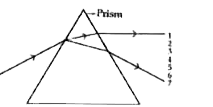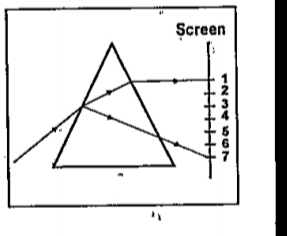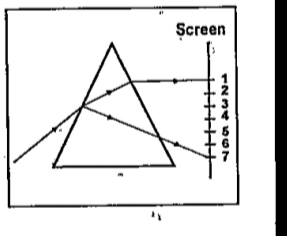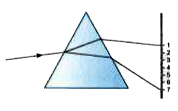A beam of white light falling a glass prism split up into seven colours marked 1 to 7 as shown in the diagram. A student makes the flowing statements about the spectrum observed on the screen : The colours at position mared 3 and 5 are similar to the colour of the sky and the colour of gold metal, respectively. Is the above statement made by the student correct or incorrect ? Justify.

Which of the above-shown positions corresponds approximately to the colour of (a) a solution of potassium permanganate and (b) 'danger' or stop signal lights ?Solution in Kannada
The colours are in the order : 1: Red, 2 : Orange, 3: Yellow, 4: Green, 5: Blue, 6: Indigo, and 7: Violet
(i) No, Because we know that the sky is blue and colour of gold metal is yellow which correspond to numbers 5 and 3 respectively. The student is stating the colours in reverse order.
(ii) (a) 7. (b) 1.
Similar Questions
A narrow beam of white light passes through a triangular glass prism and gets split up into seven colours marked 1 to 7.
A student makes the following statements about the spectrum observed on the screen:
" The colours at positions marked 3, 4 and 5 are similar 'to the colour of the sky, leaf and sunflower respectively." Is the above statement made by the student correct or incorrect ? Justify.

View SolutionA narrow beam of white light passes through a triangular glass prism and gets split up into seven colours marked 1 to 7. Which two positions correspond closely to the colour of: potassium permanganate?
View SolutionA narrow beam of white light passes through a triangular glass prism and gets split up into seven colours marked 1 to 7.
Which two positions correspond closely to the colour of:
'danger' or 'stop signal lights'?
View SolutionWhen a beam of white light passes through a triangular glass prism, it splits up into its component colours. It is due to ...........
View SolutionThe splitting up of white light into seven colours on passing through a glass prism is called
View SolutionA beam of white light falling on a glass prism gets split up into seven colours marked 1 to 7 as shown in the diagram.
A student makes the following statements about the spectrum observed on the screen.
(a) The colours at positions marked 3 and 5 are similar to the colour of the sky and the colour of gold metal respectively.
Is the above statement made by the student correct or incorrect? Justify.
(b) Which two positions correspond closely to the colour of
(i) brinjal, (ii) 'danger' or stop signal lights?

View SolutionA beam of white light falling on a glass prism gets split up into seven colours marked 1 to 7 as shown in the diagram.
A student makes the following statements about the spectrum observed on the screen.

(a) The colours at positions marked 3 and 5 are similar to the colour of the sky and the sky and the colour of gold metal respectively. Is the above statement made by the student correct or incorrect? Justify.
(b) Which two positions correspond closely to the colour of
(i) brinjal, (ii) 'danger’ or stop signal lights?
View SolutionA beam of white light falling a glass prism split up into seven colours marked 1 to 7 as shown in the diagram. A student makes the flowing statements about the spectrum observed on the screen : The colours at position mared 3 and 5 are similar to the colour of the sky and the colour of gold metal, respectively. Is the above statement made by the student correct or incorrect ? Justify.

Which of the above-shown positions corresponds approximately to the colour of (a) a solution of potassium permanganate and (b) 'danger' or stop signal lights ?
View Solution
